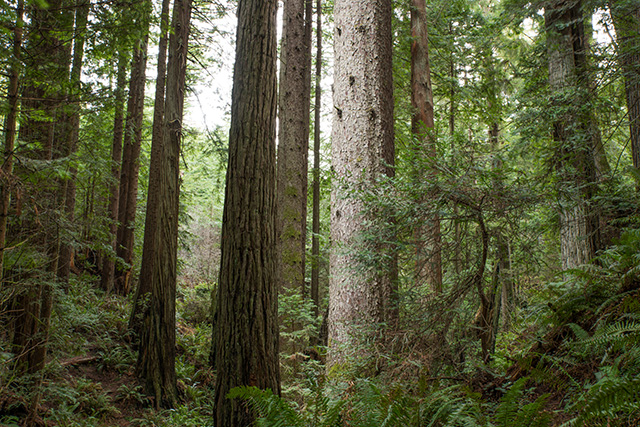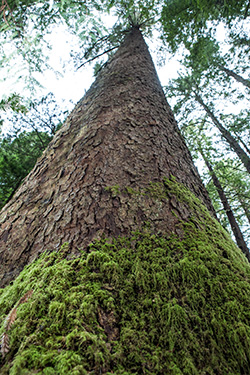
Download a 3D interactive PDF of the Sitka spruce here. Note file must be downloaded and opened in Adobe Acrobat to enable 3D interaction.
At 130 years old, the spruce is a youngster compared to some of its siblings, although finding older trees can be difficult due to the spruce’s appeal on the lumber market. Spruce is a uniquely useful wood. It has an ideal strength to weight ratio leading manufacturers to use it for paper, musical instruments, ship masts, furniture, and early aircraft. The trees are also known for their speedy growth and they are the only conifers that are capable of reaching 300 feet by 200 years old in ideal conditions. “I think this tree can do it,” says Sillett, who estimates the tree has added 10 feet since he and his students took the measurements in 2014.
Named after the Sitka community of Alaska, the spruce is easily the tallest of the spruce family and is the fifth-largest conifer in the world, behind giant sequoia, coast redwood, New Zealand’s kauri trees, and the western red cedar.
The Sitka spruce is located near Fern Lake, a manmade reservoir a few hundred yards east of HSU’s athletics complex that was designed to feed fresh water to the campus’s fish hatchery. No doubt the tree has been passed by countless disc golfers as they play the Arcata course, but it’s likely few stopped to notice the towering giant.

The spruce catches the eye with its thin purplish bark made up of individual potato-chip sized scales. Moss appears in patches at the bottom of the tree’s trunk, eventually giving way to massive limbs that begin about 30 meters up the tree. Impressively, Sillett noted, the tree still has its original tip, something most trees of that age will lose to wind or other natural events.
While the tree is located within the bounds of the HSU campus, it can be difficult for visitors to know when HSU ends and the Arcata Community Forest begins. This particular patch of forest is a testament to nature’s enduring regenerative power. Having been thoroughly logged in the last century, the forest contains an incredible amount of high biomass for a formerly-logged second growth forest—and that’s despite the fact that for years the forest’s recovery was essentially unplanned. “This is one of the best examples of a second growth forest,” says Sillett.
According to the City of Arcata’s website, the forest can absorb and store approximately 2,500 more metric tons of C02 a year than neighboring forests, or the equivalent of taking an extra 550 cars off the road each year. The Arcata Community Forest technically acts as a carbon sink because the growth of immature trees exceeds the effects of timber removal.
HSU Has Reputation for Outstanding Grounds
In 2012, HSU was lauded by the California Garden Clubs, Inc., for, among other things, “its abundance of native plants and trees and their colorful foliage.” The group bestowed a Landscape Design Commendation upon HSU, stating, “the design is also an asset to the community.”
The award-winning landscape also features ‘moon trees,’ so called because the seeds of these redwoods orbited the moon in the Apollo 14 lunar module. It was all part of an experiment carried out by astronaut Stuart Roosa, who wanted to investigate the effects of zero gravity on the seminal development of different tree species. To Roosa’s surprise, nearly all of the seeds he took with him into space germinated and many made their way to HSU where they were planted. Decades later, there is no discernible difference between moon trees and terrestrial redwoods.
The university’s largest stand of trees is actually located 45 minutes east of campus near the Korbel logging community. Officially called the L.W. Schatz Demonstration Tree Farm, the plot is a 400-acre living laboratory managed by L.W. Schatz’s son, Gordon Schatz. Along with generous funding to establish the Schatz Energy Research Center, the Schatz family donated this acreage in 1987. Today students use it for graduate studies and developing skills with forestry techniques.